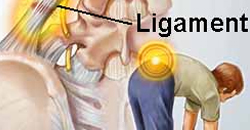
Know Your Back Pain
Almost everyone will experience low back pain at some point in their lives. This pain can vary from mild to severe. It can be short-lived or long-lasting. However it happens, low back pain can make many everyday activities difficult to do.Back pain is different from one person to the next. The pain can have a slow onset or come on suddenly. The pain may be intermittent or constant.
Cause
Lumbar ligament tear.
There are many causes of low back pain. It sometimes occurs after a specific movement such as lifting or bending. Just getting older also plays a role in many back conditions.As we age, our spines age with us. Aging causes degenerative changes in the spine. These changes can start in our 30s — or even younger — and can make us prone to back pain, especially if we overdo our activities
These aging changes, however, do not keep most people from leading productive, and generally, pain-free lives. We have all seen the 70-year-old marathon runner who, without a doubt, has degenerative changes in her back!

Over-activity
One of the more common causes of low back pain is muscle soreness from over-activity. Muscles and ligament fibers can be overstretched or injuredThis is often brought about by that first softball or golf game of the season, or too much yard work or snow shoveling in one day. We are all familiar with this "stiffness" and soreness in the low back — and other areas of the body — that usually goes away within a few days

Disk Injury
Some people develop low back pain that does not go away within days. This may mean there is an injury to a disk.Disk tear
Small tears to the outer part of the disk (annulus) sometimes occur with aging. Some people with disk tears have no pain at all. Others can have pain that lasts for weeks, months, or even longer. A small number of people may develop constant pain that lasts for years and is quite disabling. Why some people have pain and others do not is not well understood
Disk herniation
Another common type of disk injury is a "slipped" or herniated discHerniated disk.
A disk herniates when its jelly-like center (nucleus) pushes against its outer ring (annulus). If the disk is very worn or injured, the nucleus may squeeze all the way through. When the herniated disk bulges out toward the spinal canal, it puts pressure on the sensitive spinal nerves, causing pain.Because a herniated disk in the low back often puts pressure on the nerve root leading to the leg and foot, pain often occurs in the buttock and down the leg. This is sciatica.
A herniated disk often occurs with lifting, pulling, bending, or twisting movements.

Disk degeneration.
With age, intevertebral disks begin to wear away and shrink. In some cases, they may collapse completely and cause the facet joints in the vertebrae to rub against one another. Pain and stiffness result.This "wear and tear" on the facet joints is referred to as osteoarthritis. It can lead to further back problems, including spinal stenosis.

Spondylolisthesis.
Degenerative Spondylolisthesis (Spon-dee-low-lis-THEE-sis). Changes from aging and general wear and tear make it hard for your joints and ligaments to keep your spine in the proper position. The vertebrae move more than they should, and one vertebra can slide forward on top of another. If too much slippage occurs, the bones may begin to press on the spinal nerves.
Spinal Stenosis
Spinal stenosis occurs when the space around the spinal cord narrows and puts pressure on the cord and spinal nerves. When intervertebral disks collapse and osteoarthritis develops, your body may respond by growing new bone in your facet joints to help support the vertebrae. Over time, this bone overgrowth - called spurs - can lead to a narrowing of the spinal canal. Osteoarthritis can also cause the ligaments that connect vertebrae to thicken, which can narrow the spinal canal.
Spinal Stenosis
Spinal stenosis occurs when the space around the spinal cord narrows and puts pressure on the cord and spinal nerves. When intervertebral disks collapse and osteoarthritis develops, your body may respond by growing new bone in your facet joints to help support the vertebrae. Over time, this bone overgrowth - called spurs - can lead to a narrowing of the spinal canal. Osteoarthritis can also cause the ligaments that connect vertebrae to thicken, which can narrow the spinal canal.
Scoliosis
This is an abnormal curve of the spine that may develop in children, most often during their teenage years. It also may develop in older patients who have arthritis. This spinal deformity may cause back pain and possibly leg symptoms, if pressure on the nerves is involved.
Additional Causes
There are other causes of back pain, some of which can be serious. If you have vascular or arterial disease, a history of cancer, or pain that is always there despite your activity level or position, you should consult your primary care doctor.Symptoms
Back pain varies. It may be sharp or stabbing. It can be dull, achy, or feel like a "charley horse" type cramp. The type of pain you have will depend on the underlying cause of your back pain.Most people find that reclining or lying down will improve low back pain, no matter the underlying cause.
People with low back pain may experience some of the following:
Tests and Diagnosis
Medical History and Physical Examination After discussing your symptoms and medical history, your doctor will examine your back. This will include looking at your back and pushing on different areas to see if it hurts. Your doctor may have you bend forward, backward, and side to side to look for limitations or pain.Your doctor may measure the nerve function in your legs. This includes checking your reflexes at your knees and ankles, as well as strength testing and sensation testing. This might tell your doctor if the nerves are seriously affected.